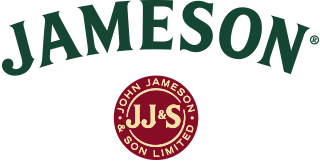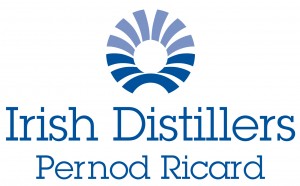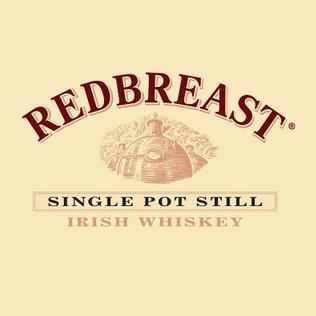
Irish whiskey is whiskey made on the island of Ireland. The word 'whiskey' comes from the Irish uisce beatha, meaning water of life. Irish whiskey was once the most popular spirit in the world, though a long period of decline from the late 19th century onwards greatly damaged the industry, so much so that although Ireland boasted at least 28 distilleries in the 1890s, by 1966 this number had fallen to just two, and by 1972 the remaining distilleries, Bushmills Distillery and Old Midleton Distillery, were owned by just one company, Irish Distillers.

Pernod Ricard is a French company best known for its anise-flavoured pastis apéritifs Pernod Anise and Ricard Pastis. The world's second-largest wine and spirits seller, it also produces several other types of pastis.

Tullamore Dew, rendered in most branding as Tullamore D.E.W., is a brand of Irish whiskey produced by William Grant & Sons. It is the second-largest-selling brand of Irish whiskey globally, with sales of over 1,500,000 cases per annum as of 2020.

Jameson is a blended Irish whiskey produced by the Irish Distillers subsidiary of Pernod Ricard. Originally one of the six main Dublin whiskeys at the Jameson Distillery Bow St., Jameson is now distilled at the New Midleton Distillery in County Cork. It is by far the best-selling Irish whiskey in the world; in 2019, annual sales passed 8 million cases. It has been sold internationally since the early 19th century, and is available to buy in over 130 countries.

Paddy is a brand of blended Irish whiskey produced by the Sazerac Company. As of 2016, Paddy is the fourth largest-selling Irish whiskey in the World.

Powers is a brand of Irish whiskey produced by the Irish Distillers subsidiary of Pernod Ricard. Historically a single pot still whiskey, the flagship Powers Gold Label brand was the first Irish whiskey ever to be bottled. Powers Gold Label was the best-selling whiskey in Ireland.
New Midleton Distillery is situated in Midleton, County Cork, Ireland. Established in 1975 and owned by Irish Distillers, a subsidiary of Pernod Ricard. Located alongside is the Old Midleton Distillery, which was established in the early 17th century and now operates as a visitor centre known as the Jameson Experience.

Irish Distillers is a subsidiary of the French drinks conglomerate Pernod Ricard. It is the largest distiller of Irish whiskey, distilling popular brands such as Jameson and Powers, in addition to premium whiskeys such as Redbreast and Midleton Very Rare. In addition to whiskey, Irish Distillers also produces a number of other spirit products such as gin and vodka.

Redbreast is a brand of single pot still Irish Whiskey produced by the Irish Distillers subsidiary of Pernod Ricard. It was originally bottled by Gilbey's, a Dublin spirits merchant using distillate sourced from Jameson's Bow Street Distillery. In the 1980s, the brand was purchased by Irish Distillers, the producer of Jameson. It is the largest selling single pot still Irish whiskey in the world.

Cork Distilleries Company was an Irish whiskey distilling company. It was formed in 1867, when four Cork distilleries, Daly's, the Green, North Mall, the Watercourse were amalgamated under one company to form the Cork Distilleries Company. In 1868, these were joined by another Cork distillery, James Murphy's Midleton Distillery. The company existed until 1966, when the Cork Distilleries Company merged with two other Irish distillers, John Powers & Son and John Jameson & Son, to form Irish Distillers.

Dingle Distillery is an Irish whiskey distillery established in 2012 and owned by the Porterhouse Brewing Company.

Jameson Distillery Bow St. is an former Irish whiskey distillery and a tourist attraction located just off Smithfield Square in Dublin, Ireland. Jameson Distillery Bow St. is the original site where Jameson Irish Whiskey was distilled until 1971. It is now a visitors centre that provides guided tours, tutored whiskey tastings, JJs bar and a gift shop.

The Old Midleton Distillery, also known as the Jameson Experience, Midleton, is an former Irish whiskey distillery that was turned into a museum and visitor centre located in Midleton, County Cork, Ireland. Set over 15 acres, since opening as a visitor's centre in 1992, the old distillery has received approximately 100,000 guests per year, receiving 125,000 in 2015.

Allman's Bandon Distillery was an Irish whiskey distillery which was established in 1826 in Bandon, County Cork, Ireland. The distillery closed in 1929 following financial difficulties. However, agents for the company trading under the name Allman, Dowden & Co., may have continued to sell off the existing stock which had built up in bonded warehouses, in both cask and bottled form, until 1939.

The North Mall Distillery was an Irish whiskey distillery located in Cork City, Ireland. In its day one of the most famous distilleries in Ireland, the distillery was destroyed by a fire in 1920. Distilling operations never resumed at the North Mall after the fire, and it was later converted into a bottling and storage facility which was used by Irish Distillers until 2007, at which point operations were transferred to Irish Distillers' other bottling facilities in Dublin. In the mid-2000s, much of the site was jointly acquired by University College Cork and Mercy University Hospital, and has since been redeveloped.

Teeling Distillery is an Irish whiskey distillery established in Dublin in 2015 by the Teeling Whiskey Company and owned by Bacardi Limited.

The Dundalk Distillery was an Irish whiskey distillery that operated in Dundalk, County Louth, Ireland between 1708 and 1926. It is thought to have been one of the old registered distilleries in Ireland. Two of the distillery buildings, the grain store and maltings, still exist and now house the County Museum and Dundalk Library.

Daly's Distillery was an Irish whiskey distillery which operated in Cork City, Ireland from around 1820 to 1869. In 1867, the distillery was purchased by the Cork Distilleries Company (CDC), in an amalgamation of five cork distilleries. Two years later, in 1869, as the smallest CDC distillery, Daly's Distillery ceased operations. In the years that followed its closure, some of the buildings became part of Shaw's Flour Mill, and Murphy's Brewery, with others continuing to be used as warehouses by Cork Distilleries Company for several years.
The Green Distillery was an Irish whiskey distillery which was established in Cork City, Ireland in 1796. In 1867, the distillery was purchased by the Cork Distilleries Company (CDC), in an amalgamation of five Cork distilleries. Production of whiskey at the distillery likely ceased soon afters its acquisition by the CDC. However, the distillery is known to have remained in use a bonded store by the Cork Distilleries Company for several years thereafter. In the mid-twentieth century, the distillery resumed operations as a gin distillery for a period of time, however, it has since been almost completely demolished.
The Old Tullamore Distillery was an Irish whiskey distillery which was established in Tullamore, County Offaly, Ireland, in 1829. The original home of Tullamore Dew Irish whiskey, the distillery closed in 1954, having endured financial difficulties for many years, like many Irish whiskey distilleries of the early 20th century.

















